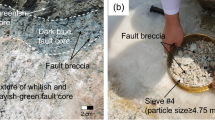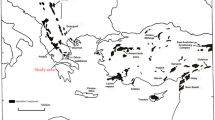Abstract
Triaxial strengths are difficult to obtain when the rock is very heterogeneous with respect to particle size and particle lithology and the samples are difficult to obtain and prepare. A fault breccia with clasts weaker than the matrix was investigated. It was found that its strength was related to the proportion of the blocks and the size of the specimen. The volumetric block proportion and texture coefficient were evaluated by core scanning and image processing. Triaxial compressive strength tests were conducted on different sized cores and different proportions of blocks. The most accurate estimations of the lower bound strength were obtained using larger diameter cores and samples with a higher volumetric block proportion.
Résumé
Les essais de compression triaxiale sont délicats à réaliser lorsque la roche est très hétérogène quant à la taille et la nature pétrographique des constituants, le prélèvement et la préparation des échantillons étant très difficiles. Une brèche de faille présentant des fragments de roche tendre dans une matrice plus résistante a été étudiée. Il est apparu que sa résistance dépendait de la proportion de fragments rocheux et de la taille de l’échantillon. La proportion de fragments rocheux et un coefficient de texture ont été évalués à partir du traitement d’images scanner des échantillons. Les essais de compression triaxiale ont été réalisés sur des échantillons de différentes tailles et présentant des proportions variées de fragments rocheux. Les estimations les plus précises quant à la limite inférieure de résistance ont été obtenues pour les échantillons de plus grand diamètre et comportant les plus fortes proportions de fragments rocheux.









Similar content being viewed by others
References
Azzoni A, Bailo F, Rondena E, Zaninetti A (1996) Assessment of texture coefficient for different rock types and correlation with uniaxial compressive strength and rock weathering. Rock Mech Rock Eng 29:36–46
Bell FG (1978) The physical and mechanical properties of the Fell Sandstones, Northumberland, England. Eng Geol 12:1–29
Burgi C, Parriaux A, Franciosi G (2001) Geological characterization of weak cataclastic fault rocks with regards to the assessment of their geomechanical properties. Q J Eng Geol Hdyrogeol 34:225–232
Chester FM, Logan JM (1986) Implications for mechanical properties of brittle faults from observations of the Punchbowl Fault Zone, California. Pure Appl Geophys 124:79–106
Ehrbar H, Pfenniger I (1999) Umsetzung der Geologie in technische Massnahmen im Tavetscher Zwischenmassive Nord. In: Loew S, Wyss R (eds) Vorerkundung und Prognose der Basistunnels am Gotthard und am Lötschberg. Balkema, Rotterdam, pp 381–394
Goodman RE, Ahlgren CS (2000) Evaluating safety of concrete gravity dam on weak rock: Scott Dam. J Geotech Geoenvir Eng 126(5):429–442
Habimana J, Labiouse V, Descoeudres F (2002) Geomechanical characterisation of cataclastic rocks: experience from the Cleuson–Dixence project. Int J Rock Mech Min Sci 39(6):677–693
Haneberg WC (2004) Simulation of 3-D block populations to characterize outcrop sampling bias in block-in-matrix rocks (bimrocks). Felsbau-Rock Soil Eng 22:19–26
Howarth DF, Rowlands JC (1987) Quantitative assessment of rock texture and correlation with drillability and strength properties. Rock Mech Rock Eng 20:57–85
Hugman RH, Friedman M (1979) Effects of texture and composition on mechanical behaviour of experimentally deformed carbonate rocks. Amer Assoc Pet Geol Bull 63:1478–1489
Jackson R, Gorski B, Gyenge M (1995) Geotechnical Properties of Rock: A data base of physical properties of Canadian rock including both intact and residual strength. Canada Communication Group Publishing, Canada
Jeng FS, Weng MC, Lin ML, Huang TH (2004) Influence of petrographic parameters on geotechnical properties of Tertiary sandstones from Taiwan. Eng Geol 73:71–91
Kahraman S, Alber M (2006) Estimating the unconfined compressive strength and elastic modulus of a fault breccia mixture of weak rocks and strong matrix. Int J Rock Mech Min Sci 43:1277–1287
Lama RD, Vutukuri VS (1978) Handbook on mechanical properties of rock, vol 2. Trans. Tech. Publications, Clausthal-Zellerfeld
Laws S, Eberhardt E, Loew S, Descoeudres F (2003) Geomechanical properties of shear zones in the Eastern Aar Massif, Switzerland and their implication on tunnelling. Rock Mech Rock Eng 36(4):271–303
Lindquist ES (1994) The strength and deformation properties of melange. Ph.D. Dissertation, University of California at Berkeley, California. UMI, Inc., Ann Arbor
Lindquist ES, Goodman RE (1994) Strength and deformation properties of a physical model melange. In: Nelson PP, Laubach SE (eds) Proceedings of the 1st North American rock mechanics symposium. Balkema, Rotterdam, pp 843–850
Medley EW (1994) The engineering characterization of melanges and similar block-in-matrix rocks (bimrocks). Ph.D. Dissertation, University of California at Berkeley, California. UMI, Inc., Ann Arbor
Medley EW, Goodman RE (1994) Estimating the block volumetric proportions of melanges and similar block-in-matrix rocks (bimrocks). In: Nelson PP, Laubach SE (eds) Proceedings of the 1st North American rock mechanics symposium. Balkema, Rotterdam, pp 851–858
Medley EW, Lindquist ES (1995) The engineering significance of the scale-independence of some Franciscan melanges in California. In: Daemen JK, Schultz RA (eds) Proceedings of the 35th US Rock mechanics symposium. Balkema, Rotterdam, pp 907–914
Medley EW (1997) Uncertainty in estimates of block volumetric proportions in melange bimrock. In: Marinos PG, Koukis GC, Tsiambaos GC, Stournaras GC (eds) Proceedings of the international symposium on engineering geology and the environment. Balkema, Rotterdam, pp 267–272
Medley EW (2001) Orderly characterization of chaotic Franciscan Melanges. Felsbau Rock Soil Eng 19:20–33
Medley EW (2002) Estimating block size distribution of melanges and similar block-in-matrix rocks (bimrocks). In: Hammah R, Bawden W, Curran J, Telesnicki M (eds) Proceedings of the 5th North American rock mechanics symposium. University of Toronto Press, Toronto, Canada, pp 509–516
Olsson WA (1974) Grain size dependence of yield stress in marble. J Geophys Res 79:4859–4861
Onodera TF, Asoka Kumara HM (1980) Relation between texture and mechanical properties of crystalline rocks. Bull Int Assoc Eng Geol 22:173–177
Slatalla N (2004) Geological mapping at the Ahauser reservoir. Unpublished BSc thesis. Institute of Geology, Mineralogy Geophysics, Ruhr University Bochum (in German)
Sonmez H, Gokceoglu C, Tuncay E, Medley EW, Nefeslioglu HA (2004) Relationship between volumetric block proportion and overall UCS of a volcanic bimrock. Felsbau Rock Soil Eng 22:27–34
Sonmez H, Gokceoglu C, Medley EW, Tuncay E, Nefeslioglu HA (2006) Estimating the uniaxial compressive strength of a volcanic bimrock. Int J Rock Mech Min Sci 43:554–561
Ulusay R, Tureli K, Ider MH (1994) Prediction of engineering properties of selected litharenite sandstone from its petrographic characteristics using correlation and multivariate statistical techniques. Eng Geol 37:135–157
Acknowledgments
This study was supported by Alexander von Humboldt Foundation. The authors thank Dr. G. Rafat from DMT for the scanning of the cores.
Author information
Authors and Affiliations
Corresponding author
Rights and permissions
About this article
Cite this article
Kahraman, S., Alber, M. Triaxial strength of a fault breccia of weak rocks in a strong matrix. Bull Eng Geol Environ 67, 435–441 (2008). https://doi.org/10.1007/s10064-008-0152-3
Received:
Accepted:
Published:
Issue Date:
DOI: https://doi.org/10.1007/s10064-008-0152-3




